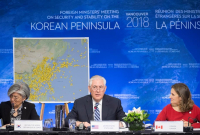Support strong Canadian climate journalism for 2025
The crew of a Canadian warship in the Pacific had front-row seats to potential violations of UN sanctions against North Korea during a recent patrol in the East China Sea — but was under orders not to intercept any suspicious vessels, the ship's commander says.
Crew members on HMCS Calgary instead took photos and collected other information, Cmdr. Blair Saltel said Tuesday.
"We saw several ship-to-ship transfers at sea and by the markings — based on the intelligence that we had — some of those were associated with ... potential violators of those sanctions," Saltel said.
"We maintained a (distance), and that's in (accordance) with the entire approach to the operation. We took pictures, we passed that information to the higher authorities and the expectation is that could be used for legal sanctions."
HMCS Calgary is the first Canadian military vessel to deploy to the area after the federal government agreed earlier this year to help the U.S. and other allies crack down on smuggling designed to subvert sanctions against North Korea.
Western security officials have previously accused Russia and China of exporting oil to North Korea — or at least turning a blind eye as their companies do — which would be a violation of sanctions. Both countries have denied the charge.
While the Canadian frigate did not intercept any vessels, Saltel said the mere presence of a Western warship was enough in some cases to cause the other vessels to turn tail and run.
"We noted in a few instances that the transfers would wrap up quite quickly and they would have to escape. So our presence disrupted several of the transfers. But we had no intention of actually doing something as forceful as boarding or blocking a ship."
The Calgary and the navy's interim support ship, MV Asterix, are wrapping up a six-month deployment in the Pacific off Asia, during which they also participated in several multinational military exercises and visited several countries.
One of the main objectives was to demonstrate Canada's naval presence in a part of the world that is growing increasingly important to Canadian prosperity and international security.
Saltel said the deployment has included being shadowed by Chinese naval vessels in the South and East China Seas, which has become routine for Western military ships operating in the area amid growing tensions over competing territorial claims.
The U.S., the United Kingdom and other allies have made a point of sailing close to disputed islands and through disputed waters claimed by China, prompting several close calls and tense moments as the latter flexes its muscles.
The situation in the South China Sea, in particular, has been compared to a powder keg, as Chinese and U.S. naval vessels have almost collided as the U.S. navy has conducted "freedom of navigation" operations.
Saltel said he was not directed to do anything like that, and while HMCS Calgary did sail near the disputed Spratly Islands, its course was intended to save fuel and not to send a message to China.
The Canadian officer said his Chinese "shadows" acted professionally and "never really came within a distance that I would have considered unsafe."
HMCS Calgary's recent deployment was also unique for being the first to involve the Asterix, a converted civilian vessel that the federal government is leasing from Quebec-based Davie Shipbuilding until permanent support ships can be built.
The Asterix is captained and crewed by civilians except for a small contingent of military personnel who are responsible for providing fuel and other supplies at sea. Saltel said it has conducted about 50 such replenishments with the Calgary and allies.





Comments